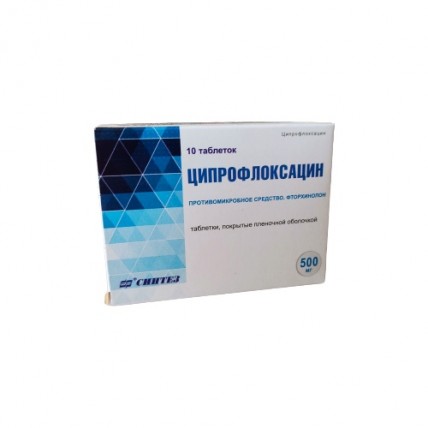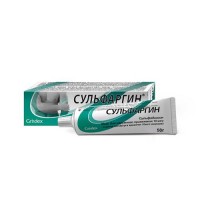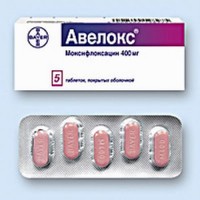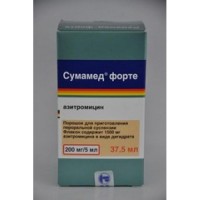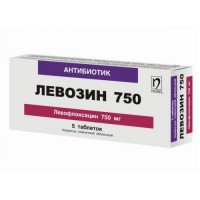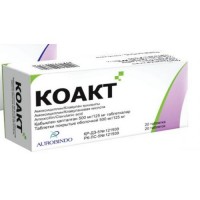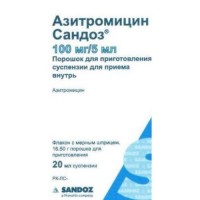Ciprofloxacin 500 mg, 10 coated tablets
- $5.00
Compound
One tablet contains
active substance - ciprofloxacin hydrochloride monohydrate 295 mg and 590 mg, (in terms of ciprofloxacin) 250 mg and 500 mg,
excipients: core composition: corn starch, pregelatinized starch, crospovidone, lactose monohydrate, microcrystalline cellulose, talc, magnesium stearate.
shell composition: hypromellose, macrogol-4000, propylene glycol, talc, copovidone, titanium dioxide E171.
Pharmacological properties
Pharmacokinetics
When taken orally, ciprofloxacin is rapidly and completely absorbed from the gastrointestinal tract (GIT) (mainly in the duodenum and jejunum). Food intake slows down absorption, but does not change the maximum concentration (Cmax) and bioavailability. Bioavailability - 50-85%, volume of distribution - 2-3.5 l / kg, connection with plasma proteins - 20-40%. The time to reach the maximum concentration (TCmax) with oral administration is 60-90 minutes, Cmax linearly depends on the dose taken and is 1.2 and 2.4 μg / ml at doses of 250 and 500 mg, respectively. 12 hours after ingestion of 250 and 500 mg, the concentration of the drug in the plasma decreases to 0.1 and 0.2 μg / ml, respectively.
Ciprofloxacin is well distributed in body tissues (excluding tissue rich in fats, such as nerve tissue). Concentration in tissues is 2-12 times higher than in plasma. Therapeutic concentrations are achieved in saliva, tonsils, liver, gallbladder, bile, intestines, abdominal and pelvic organs (endometrium, fallopian tubes and ovaries, uterus), seminal fluid, prostate tissue, kidneys and urinary organs, lung tissue, bronchial secretions , bone tissue, muscles, synovial fluid and articular cartilage, peritoneal fluid, skin In the cerebrospinal fluid (CSF) penetrates in a small amount, where its concentration in the absence of inflammation of the meninges is 6-10% of that in the blood serum, and in inflamed - 14-37%. Ciprofloxacin also penetrates well into the eye fluid, bronchial secretions, pleura, peritoneum, lymph, through the placenta. The concentration of ciprofloxacin in blood neutrophils is 2-7 times higher than in blood serum.
The activity decreases slightly at pH values less than 6.
Ciprofloxacin is metabolized in the liver (15-30%) with the formation of low-activity metabolites (diethylcyprofloxacin, sulfocyprofloxacin, oxocyprofloxacin, formylcyprofloxacin).
The half-life (T1 / 2) is about 4 hours, with chronic renal failure (CRF) - up to 12 hours.It is excreted mainly by the kidneys by tubular filtration and tubular secretion unchanged (40-50%) and in the form of metabolites (15% ), the rest with feces.
Renal clearance - 3-5 ml / min / kg; total clearance - 8-10 ml / min / kg. With chronic renal failure (creatinine clearance (CC) above 20 ml / min), the percentage of the drug excreted through the kidneys decreases, but cumulation in the body does not occur due to a compensatory increase in drug metabolism and excretion through the gastrointestinal tract.
Pharmacodynamics
Ciprofloxacin - a broad-spectrum antimicrobial drug, a quinoline derivative, inhibits bacterial DNA gyrase (topoisomerases II and IV, which are responsible for the process of supercoiling of chromosomal DNA around nuclear RNA, which is necessary for reading genetic information), disrupts DNA synthesis, growth and division of bacteria; causes pronounced morphological changes (including the cell wall and membranes) and rapid death of the bacterial cell.
It acts bactericidal on gram-negative organisms during dormancy and division (since it affects not only DNA gyrase, but also causes lysis of the cell wall), on gram-positive microorganisms - only during the half-life.
Low toxicity for cells of a macroorganism is explained by the absence of DNA gyrase in them. While taking ciprofloxacin, there is no parallel development of resistance to other antibiotics that do not belong to the group of gyrase inhibitors, which makes it highly effective against bacteria that are resistant, for example, aminoglycazides, penicillins, cephalosporins, tetracyclines and many other antibiotics.
Gram-negative aerobic bacteria are sensitive to ciprofloxacin: enterobacteria (Escherichiacoli, Salmonellaspp., Shigellaspp., Citrobacterspp., Klebsiellaspp., Enterobacterspp., Proteusmirabilis, Proteusvulgaris. bacteria (Haemophilusspp., Pseudomonasaeruginosa, Moraxellacatarrhalis, Aeromonasspp., Pasteurellamultocida, Plesiomonasshigelloides, Campylobacterjejuni, Neisseriaspp.), some intracellular pathogens - Legiongenesbacterobacterium, Brucellamonasis
gram-positive aerobic bacteria: Staphylococcusspp. (Staphylococcus aureus, Staphylococcus haemolyticus, Staphylococcus hominis, Staphylococcus saprophyticus), Streptococcus spp. (St reptococcus pyogenes, St reptococcus agalactiae). Active in relation to Bacillusanthracisin vitro.
Most methicillin-resistant staphylococci are also resistant to ciprofloxacin. The sensitivity of Streptococcus pneumoniae, Enterococcus faecalis, Mycobacteriumavium (located intracellularly) is moderate (high concentrations are required to suppress them).
Resistant to the drug: Bacteroidesfragilis, Pseudomonascepacia, Pseudomonasmaltophilia, Ureaplasmaurealyticum, Clostridiumdifficile, Nocardiaasteroids. Not effective against Treponemapallidum.
Resistance develops extremely slowly, since, on the one hand, after the action of ciprofloxacin, there are practically no persistent microorganisms, and on the other hand, bacterial cells do not have enzymes that inactivate it.
Indications for use
- acute and chronic (in the stage of exacerbation) bronchitis, pneumonia, bronchiectasis, infectious complications of cystic fibrosis
- acute sinusitis
- cystitis, pyelonephritis
- complicated intra-abdominal infections (in combination with metronidazole)
- chronic bacterial prostatitis
- uncomplicated gonorrhea
- typhoid fever, campylobacteriosis, shigellosis, travelers' diarrhea
- infected ulcers, wounds, burns, abscesses, phlegmon
- osteomyelitis, septic arthritis
- infections in patients with neutropenia
- prevention and treatment of pulmonary anthrax (Bacillusanthracis infection)
Children
- therapy of complications caused by Pseudomonas aeruginosa in children with cystic fibrosis of the lungs from 6 to 17 years old
- prevention and treatment of pulmonary anthrax (Bacillusanthracis infection)
Method of administration and dose
Inside. The tablets should be swallowed whole with a little liquid after meals. When the tablet is taken on an empty stomach, the active substance is absorbed faster.
For infections of the lower respiratory tract of mild and moderate severity - 500 mg 2 times a day, in severe cases - 750 mg 2 times a day. The course of treatment is 7-14 days.
In acute sinusitis - 500 mg 2 times a day. The course of treatment is 7-14 days.
For mild to moderate infections of the skin and soft tissues - 500 mg 2 times a day, in severe cases - 750 mg 2 times a day. The course of treatment is 7-14 days.
With infections of bones and joints of mild and moderate degree - 500 mg 2 times a day, with severe course - 750 mg 2 times a day. The course of treatment is up to 4-6 weeks.
For urinary tract infections - 250-500 mg 2 times a day, the course of treatment is 7-14 days, with uncomplicated cystitis in women - 3 days.
In chronic bacterial prostatitis - 500 mg 2 times a day, the course of treatment is 28 days.
For uncomplicated gonorrhea - 250-500 mg once.
Infectious diarrhea - 500 mg 2 times a day, the course of treatment is 5-7 days.
With typhoid fever - 500 mg 2 times a day, the course of treatment is 7 days.
For complicated intra-abdominal infections - 500 mg every 12 hours for 7-14 days.
For the prevention and treatment of pulmonary anthrax - 500 mg 2 times a day.
The duration of treatment depends on the severity of the disease, clinical and bacteriological results.
CRF: if CC is more than 60 ml / min, dose adjustment is not required; with CC 30-50 ml / min - 250-500 mg every 12 hours; with CC <30 ml / min - 250-500 mg every 18 hours. If the patient is undergoing hemodialysis or peritoneal dialysis - 250-500 mg / day, but should be taken after a hemodialysis session.
In pediatrics:
in the treatment of complications caused by Pseudomonasaeruginosa in children with cystic fibrosis of the lungs from 6 to 17 years old - 20 mg / kg 2 times a day (maximum dose 1.5 g). The duration of treatment is 10-14 days.
with pulmonary anthrax (prevention and treatment) - 15 mg / kg 2 times a day. The maximum single dose is 500 mg, the daily dose is 1 g. The total duration of ciprofloxacin intake is 60 days.
Side effects
Often
- nausea, diarrhea
Sometimes
- vomiting, abdominal pain, loss of appetite
- dizziness, headache, increased fatigue, anxiety,
- violation of taste and smell
- leukopenia, eosinophilia
Seldom
- a feeling of weakness, prolonged use of an antibiotic can cause the appearance of resistant strains of bacteria and fungi
- flatulence
- tachycardia, cardiac arrhythmias, peripheral edema
- thrombocytopenia
- hypoprothrombinemia, increased activity of "hepatic" transaminases and alkaline phosphatase, creatinine, bilirubin and urea
- vasculitis
Rarely
- joint pain, joint inflammation
- cholestatic jaundice (especially in patients with previous liver diseases), hepatitis, hepatonecrosis, pseudomembranous colitis
- tremor, insomnia, "nightmares", peripheral paralgesia (anomaly in the perception of pain), sweating, increased intracranial pressure, unsteadiness when walking, anxiety, confusion, depression, hallucinations, as well as other manifestations of psychotic reactions (rarely progressing to states, in which the patient can harm himself), migraine, fainting
- visual impairment (diplopia, change in color perception), tinnitus, hearing loss
- increased concentrations of lipase, amylase
- lowering blood pressure, cerebral artery thrombosis
- granulocytopenia, anemia, leukocytosis, agranulocytosis, thrombocytosis, pancytopenia, hemolytic anemia, bone marrow suppression, changes in prothrombin levels
- hypercreatininemia, hyperbilirubinemia, hyperglycemia
- peripheral neuropathy
- dyspnea, laryngeal edema
- psychosis, occasionally with suicidal tendencies
- hematuria, crystalluria (primarily with alkaline urine and low urine output), acute renal failure, vaginal candidiasis, glomerulonephritis, dysuria, polyuria, urinary retention, albuminuria, urethral bleeding, hematuria, decreased nitrogen excretory function of the kidneys, interstitial nephritis
- allergic reactions: sometimes - itchy skin, rarely - urticaria, swelling of the face or larynx, anaphylactic shock, very rarely - the formation of blisters, accompanied by bleeding, and the appearance of small nodules that form scabs, drug fever, pinpoint hemorrhages on the skin (petechiae), shortness of breath , eosinophilia, vasculitis, erythema nodosum, exudative erythema multiforme (including Stevens-Johnson syndrome), toxic epidermal necrolysis (Lyell's syndrome), photosensitivity reactions
- others: asthenia, increased photosensitivity, superinfections (candidiasis, pseudomembranous colitis), "hot flashes" of blood to the face, increased sweating, arthralgia, arthritis, tendovaginitis, tendon ruptures, myalgia, reactions such as serum sickness
Contraindications
- hypersensitivity to the drug
- simultaneous reception with tizanidine (risk of a pronounced decrease in blood pressure (BP), drowsiness)
- pregnancy and lactation
- adolescence up to 18 years (except for the treatment of complications caused by Pseudomonas aeruginosa in children with cystic fibrosis of the lungs from 6 to 17 years old; prevention and treatment of pulmonary anthrax infected with Bacillusanthracis)
- lactose intolerance
- lactase deficiency
- glucose-galactose malabsorption
- epilepsy
Drug interactions
Due to a decrease in the activity of microsomal oxidation processes in hepatocytes, cyprofloxacin increases the concentration and lengthens T1 / 2 of theophylline (and other xanthines, such as caffeine), oral hypoglycemic drugs, indirect anticoagulants, helps to reduce the prothrombin index.
When combined with other antimicrobial drugs (beta-lactam antibiotics, aminoglycazides, clindamycin, metronidazole), synergism is usually observed; can be successfully used in combination with azlocillin and ceftazidime for infections caused by Pseudomonasspp.; with mezlocillin, azlocillin and other beta-lactam antibiotics - for streptococcal infections; with isoxazolylpenicillins and vancomycin - for staphylococcal infections; with metronidazole and clindamycin - for anaerobic infections.
Ciprofloxacin enhances the nephrotoxic effect of cyclosporine, there is an increase in serum creatinine, in such patients it is necessary to control this indicator 2 times a week.
When taken simultaneously, it enhances the effect of indirect anticoagulants.
Oral administration together with iron-containing drugs, sucralfate and antacid drugs containing magnesium, calcium and aluminum ions leads to a decrease in the absorption of ciprofloxacin, therefore it should be prescribed 1-2 hours before or 4 hours after taking the above drugs.
Non-steroidal anti-inflammatory drugs (excluding acetylsalicylic acid) increase the risk of seizures.
Didanosine decreases the absorption of ciprofloxacin due to the formation of complexes with it with aluminum and magnesium ions contained in didanosine.
Metoclopramide accelerates absorption, which leads to a decrease in the time to reach its Cmax.
The combined use of uricosuric drugs leads to a slowdown in excretion (up to 50%) and an increase in the plasma concentration of ciprofloxacin.
Increases Cmax by 7 times (4 to 21 times) and the area under the concentration-time curve (AUC) 10 times (6 to 24 times) tizanidine, which increases the risk of a pronounced decrease in blood pressure and drowsiness.
Probenecid: Probenecid interferes with the renal excretion of ciprofloxacin. The combined use of probenecid and ciprofloxacin increases plasma concentrations of ciprofloxacin.
Omeprazole: the simultaneous use of ciprofloxacin and omeprazole leads to a slight decrease in the maximum plasma concentration and the average concentration in the urine of ciprofloxacin.
Theophylline: with the simultaneous use of siflox and theophylline, an increase in the concentration in the blood of the latter is possible. In such cases, it is necessary to adjust the dose of theophylline.
Tizanidine: simultaneous administration with tizanidine leads to an increase in the concentration of tizanidine in the blood serum, hypotension is aggravated and the sedative effect is enhanced.
Caffeine: Certain quinolones, including ciprofloxacin, decrease the clearance of caffeine and may prolong its serum half-life.
Methotrexate: The renal tubular transport of methotrexate can be inhibited while taking ciprofloxacin, which can lead to an increase in plasma methotrexate levels. As a result, may increase the risk of toxic reactions associated with the use of methotrexate. Therefore, patients taking methotrexate should be closely monitored while prescribing ciprofloxacin therapy.
Phenytoin: Concomitant use of ciprofloxacin and phenytoin can lead to an increase or decrease in plasma levels of phenytoin, therefore monitoring is recommended.
Antibiotics: The simultaneous use of cyprofloxacin and aminoglycosides and beta-lactam antibiotics gives an additive and synergistic effect.
Effects on CYP: Ciprofloxacin is a potent inhibitor of CYP1A2 and a weak inhibitor of CYP3A4.
Cyclosporine: with the simultaneous use of drugs containing ciprofloxacin and cyclosporine, a transient increase in plasma creatinine concentration was observed. Therefore, it is necessary to frequently (twice a week) monitor plasma creatinine concentrations in such patients.
Vitamin K antagonists: Concomitant use of ciprofloxacin with vitamin K antagonists may enhance its anticoagulant effect.
Glibenclamide: In some cases, the simultaneous use of ciprofloxacin and glibenclamide may increase the effect of glibenclamide (hypoglycemia).
Duloxetine: In clinical studies, it was found that the simultaneous use of duloxetine with strong inhibitors of the isoenzyme cytochrome P450 1A2, such as fluvoxamine, can lead to an increase in the average concentration in urine and maximum plasma concentration of duloxetine. Although there is no clinical data for a possible interaction with ciprofloxacin, similar effects can be expected with a single use.
Ropinirole: it was found in a clinical study that the simultaneous use of ropinirole, which is an inhibitor of the cytochrome P450 1A2 isoenzyme of medium power, with ciprofloxacin leads to an increase in the average concentration in urine and maximum plasma concentration of ropinirole by 84% and 60%, respectively. It is recommended to monitor for side effects caused by ropinirole and adjust dosages during and after a single use with ciprofloxacin.
Lidocaine: in healthy people, it was found that the simultaneous use of drugs containing lidocaine, which is an inhibitor of the cytochrome P450 1A2 isoenzyme of medium power, with ciprofloxacin, reduces the clearance of intravenously administered lidocaine by 22%. Although lidocaine therapy was well tolerated, a possible interaction with ciprofloxacin may occur during a single use, leading to side effects.
Clozapine: at the end of a single use of 25 0 mg of ciprofloxacin with clozapine for 7 days, the plasma concentrations of clozapine and N-desmethylclozapine were increased by 29% and 31%, respectively. Clinical observation and adequate dosage adjustment of clozapine during and after a single use with ciprofloxacin are recommended.
Sildenafil: the simultaneous use of sildenafil with ciprofloxacin leads to an increase in the average concentration in urine and maximum plasma concentration of sildenafil approximately twice after an oral dosage of 50 mg at a time with 500 mg of ciprofloxacin. Therefore, caution should be exercised when prescribing combination therapy, taking into account the risks and potential benefits.
Food and dairy products: Calcium in the form of a nutrient does not significantly affect absorption. However, the simultaneous use of dairy products or beverages fortified with minerals (for example, milk, yogurt, orange juice, fortified with minerals) with ciprofloxacin should be avoided due to the possible decrease in absorption of ciprofloxacin.
Special instructions
With care: severe atherosclerosis of cerebral vessels, cerebrovascular accident, mental illness, epilepsy, severe renal and / or hepatic failure, old age, tendon lesions during previous fluoroquinolone therapy.
Ciprofloxacin is not the drug of choice for suspected or established Streptococcuspneumoniae pneumonia.
In order to avoid the development of crystalluria, it is unacceptable to exceed the recommended daily dose; it is also necessary to have sufficient fluid intake and maintain an acidic urine reaction.
Patients with epilepsy, a history of seizures, vascular diseases and organic brain lesions, due to the threat of adverse reactions from the central nervous system (CNS), ciprofloxacin should be prescribed only for "vital" indications.
If severe and prolonged diarrhea occurs during or after treatment, the diagnosis of pseudomembranous colitis should be excluded, which requires immediate discontinuation of the drug and the appointment of appropriate treatment.
Cases of polyneuropathy (based on neurological symptoms such as pain, burning, sensory impairment or muscle weakness, alone or in combination) have occurred in patients treated with ciprofloxacin. The drug should be discontinued in patients with symptoms of neuropathy, including pain, burning, tingling, numbness, and / or weakness in order to prevent the development of irreversible disorders.
There are cases of serious and fatal reactions in patients concomitantly using ciprofloxacin and theophylline. These reactions included cardiac arrest, seizures, epilepticus, and respiratory failure. Although these reports refer to similar serious adverse effects in patients receiving theophylline alone, the possibility that ciprofloxacin may cause these reactions has not been ruled out. If concomitant use cannot be avoided, then serum theophylline levels should be checked and appropriate dosage adjustments made.
Quinolone therapy may be associated with hypersensitivity reactions, even after a single dose. Drug therapy should be discontinued at the first sign of an allergic reaction. In severe anaphylactic reactions, immediate emergency care is required.
As with other broad-spectrum antimicrobial agents, prolonged use of the drug can lead to overgrowth of insensitive microorganisms and superinfection. As in the case of other highly effective drugs, against the background of prolonged therapy, it is recommended to periodically assess the functions of organs and systems, including renal, hepatic and hematopoietic functions.
CYP450: Ciprofloxacin is an inhibitor of the hepatic CYP1A2 enzyme pathway. Co-administration of ciprofloxacin with other drugs, primarily metabolized by CYP1A2 (eg, theophylline, methylxanthines, tizanidine), leads to increased plasma concentrations of drugs administered together, and can lead to clinically significant pharmacodynamic side effects of drugs administered together.
Severe infections and mixed - gram infections - positive and anaerobic pathogens.
Cyprofloxacin monotherapy is not intended for the treatment of severe infections and infections possibly caused by gram-positive or anaerobic pathogens. For such infections, ciprofloxacin should be used in conjunction with other adequate antibacterial drugs.
Streptococcal infections (including those caused by Streptococcus Pneumoniae).
Ciprofloxacin is not recommended for use in the treatment of streptococcal infections due to the inadequate level of efficacy.
Urinary tract infections.
Fluoroquinolone-resistant gonococcal urethritis, cervicitis, epididymo-orchitis, and pelvic inflammatory disease can be caused by isolated strains of Neisseria Gonorrhoeae.
Therefore, ciprofloxacin should be used for the treatment of gonococcal urethritis or cervicitis only if ciprofloxacin, a resistant microorganism, is excluded.
For the treatment of epididymo-orchitis and pelvic inflammatory disease, empirical use of ciprofloxacin should be considered only in combination with other adequate antibacterial agents (eg, cephalosporin), unless ciprofloxacin-resistant organisms are excluded on the basis of data. If there is no clinical improvement on the third day of therapy, it should be canceled.
Urinary tract infections.
Resistance to fluoroquinolones from E. coli, the most common pathogen involved in the development of urinary tract infections. Physicians are advised to consider the local prevalence of fluoroquinolone-resistant Escherichia coli.
A single dose of ciprofloxacin has been estimated to be associated with lower efficacy than long-term therapy. This should also be taken into account in relation to the increasing level of resistance of E. coli to quinolones.
Intra-abdominal infections.
There is limited data on the effectiveness of therapy for postoperative intra-abdominal infections.
Traveler's diarrhea.
When choosing ciprofloxacin, information on ciprofloxacin resistance of the relevant pathogens in the countries visited should be considered.
Infectious pathologies of bones and joints.
Ciprofloxacin should be used in combination with other antibacterial agents, depending on the results of microbiological testing.
The musculoskeletal system.
In general, ciprofloxacin should not be used in patients with a history of tendon disease / disorder associated with ciprofloxacin. However, in very rare cases, after microbiological examination of the etiological agent and careful analysis of the risk-benefit ratio, ciprofloxacin can be prescribed to such patients for the treatment of certain severe infections, in particular in the case of failure of standard therapy or the presence of resistance of microorganisms, provided that microbiological examination justifies the use of ciprofloxacin.
Under the conditions of ciprofloxacin use, tendinitis and tendon ruptures (especially the Achilles tendon) can develop, sometimes in a bilateral version, and even in the first 48 hours after starting therapy. Inflammation and tendon ruptures may occur even several months after ciprofloxacin therapy is discontinued. The risk of tendinopathy may be increased in elderly patients or in patients receiving concomitant corticosteroid therapy.
If you have any symptoms of tendonitis (eg, painful swelling, inflammation), ciprofloxacin therapy should be discontinued. Rest of the affected limb should be observed.
Ciprofloxacin should be used with caution in patients with severe pseudoparalytic myasthenia gravis.
Photosensitization.
Ciprofloxacin has been shown to induce photosensitization reactions. Patients taking ciprofloxacin should avoid direct contact with sunlight or UV radiation during treatment.
Violations of the cardiovascular system.
Quinolones should be used with caution in patients with known risk factors for QT prolongation, such as:
- hereditary syndrome of long QT - interval;
- the simultaneous use of drugs that prolong the QT - interval (for example, antiarrhythmics of classes 1A and 3, tricyclic antidepressants, macrolides, antipsychotic drugs).
- uncorrected electrolyte disturbances (for example, hypokalemia, hypomagnesemia);
- cardiac pathologies (for example, heart failure, myocardial infarction, bradycardia).
Elderly patients and women may be more sensitive to QT-prolonging drugs.
Therefore, caution should be exercised when using fluoroquinolones, including ciprofloxacin, in these populations.
Cases of crystalluria associated with ciprofloxacin have been reported. Patients receiving ciprofloxacin should drink adequately, and an excessively alkaline urine reaction should be avoided.
Renal dysfunction.
Since ciprofloxacin is mainly excreted unchanged through the kidneys in patients with impaired renal function, dosage adjustment is required to avoid aggravating the side effects of the drug due to the accumulation of ciprofloxacin.
Features of the effect of the drug on the ability to drive a vehicle or potentially dangerous mechanisms
During treatment, one should refrain from driving and maintaining machines and mechanisms that require increased concentration of attention and speed of psychomotor reactions.
When using ciprofloxacin, avoid direct sunlight and intense ultraviolet radiation. In case of photosensitivity (the appearance of burn-like skin reactions), the drug should be discontinued.
Overdose
Symptoms: increased side effects of the drug.
Treatment: the specific antidote is unknown. Gastric lavage and other emergency measures, careful monitoring of the patient's condition, ensuring an adequate supply of fluid. With the help of hemo- or peritoneal dialysis, only a small (less than 10%) amount of the drug can be removed.
Storage conditions
Store in a dry, dark place at a temperature not exceeding 25 ° C
Keep out of the reach of children!
Shelf life - 5 years
Do not use after the expiration date.
